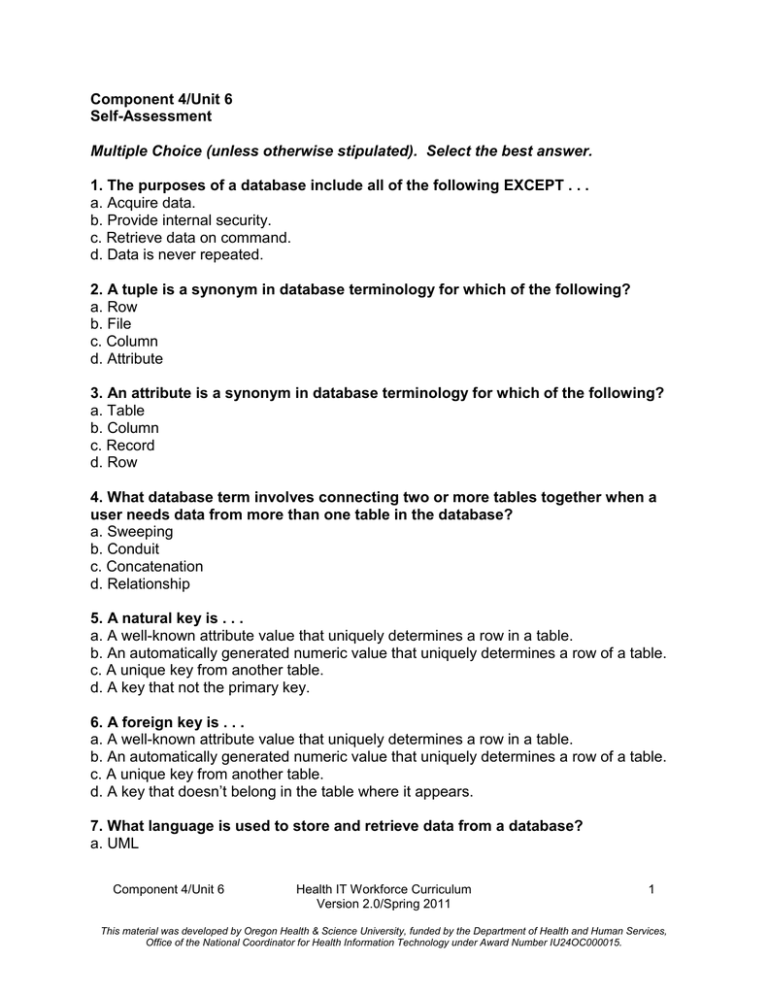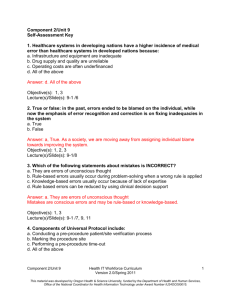Component 4/Unit 6 Self-Assessment
advertisement

Component 4/Unit 6 Self-Assessment Multiple Choice (unless otherwise stipulated). Select the best answer. 1. The purposes of a database include all of the following EXCEPT . . . a. Acquire data. b. Provide internal security. c. Retrieve data on command. d. Data is never repeated. 2. A tuple is a synonym in database terminology for which of the following? a. Row b. File c. Column d. Attribute 3. An attribute is a synonym in database terminology for which of the following? a. Table b. Column c. Record d. Row 4. What database term involves connecting two or more tables together when a user needs data from more than one table in the database? a. Sweeping b. Conduit c. Concatenation d. Relationship 5. A natural key is . . . a. A well-known attribute value that uniquely determines a row in a table. b. An automatically generated numeric value that uniquely determines a row of a table. c. A unique key from another table. d. A key that not the primary key. 6. A foreign key is . . . a. A well-known attribute value that uniquely determines a row in a table. b. An automatically generated numeric value that uniquely determines a row of a table. c. A unique key from another table. d. A key that doesn’t belong in the table where it appears. 7. What language is used to store and retrieve data from a database? a. UML Component 4/Unit 6 Health IT Workforce Curriculum Version 2.0/Spring 2011 1 This material was developed by Oregon Health & Science University, funded by the Department of Health and Human Services, Office of the National Coordinator for Health Information Technology under Award Number IU24OC000015. b. DDLC c. DBMS d. SQL 8. Which part of the database ER-diagram becomes a table in the implemented database? a. Relationships b. Entities c. Attributes d. Primary keys 9. Relationships in the database are carried out with the use of which of the following? a. Primary key to foreign key matches. b. Surrogate key to natural key matches. c. Foreign key to foreign key matches. d. Primary key to primary key matches. 10. Attributes that contain more than one piece of data such as Address are called . . a. Multi-valued b. Composite c. An unbound domain d. Unspecific 11. Primary keys are most efficient for data retrieval when they are which of the following? a. Short and numeric b. Shared primary keys c. Composite d. Multi-valued 12. An example of a one-to-one relationship is which of the following? a. Patient to Doctor b. Nurse to work shift c. Drug to pharmaceutical company d. Patient to Hospital wrist band ID 13. An example of a one-to-many relationship is which of the following? a. Insured to dependents b. Patient to Hospital wrist band ID c. Patient to Insurance Co d. Hospital medical procedure to patient Component 4/Unit 6 Health IT Workforce Curriculum Version 2.0/Spring 2011 2 This material was developed by Oregon Health & Science University, funded by the Department of Health and Human Services, Office of the National Coordinator for Health Information Technology under Award Number IU24OC000015. 14. An example of a many-to-many relationship is which of the following? a. Patient to hospital wrist band ID b. Hospital medical procedure to patient c. Insured to dependents d. Toxicology report to Patient 15. SQL commonly produces or projects which of the following? a. one logical record b. users of the system c. record sets d. one attribute 16. Which of the following is involved in data modeling? a. ER-diagram b. SQL c. Implementing the database d. Maintaining the database 17. Constraints ensure that____________. a. attributes are related. b. attributes can be considered candidate keys cattribute values follow rules d. user access to the database is limited 18. Which normal form is commonly considered to be all that is necessary for most database situations? a. Second normal form b. Third normal form c. Boyce-Codd form d. Fourth normal form 19. SQL is used to create tables (True or False). a. true b. false 20. The SQL statement used to retrieve data from a database is which of the following? a. UPDATE b. SELECT c. INSERT d. WHERE 21. “Order By” is which of the following? a. type of statement Component 4/Unit 6 Health IT Workforce Curriculum Version 2.0/Spring 2011 3 This material was developed by Oregon Health & Science University, funded by the Department of Health and Human Services, Office of the National Coordinator for Health Information Technology under Award Number IU24OC000015. b. function c. clause d. transaction processing statement 22. “Count” is which of the following? a. type of statement b. function c. clause d. transaction processing statement 23. The term used for the process of getting data out of more than one table is which of the following? a. Group By b. And or Or c. Distinct d. Join 24. In transaction processing changes to the database can be retracted before the end of the transaction is reached (true or false). a. true b. false Component 4/Unit 6 Health IT Workforce Curriculum Version 2.0/Spring 2011 4 This material was developed by Oregon Health & Science University, funded by the Department of Health and Human Services, Office of the National Coordinator for Health Information Technology under Award Number IU24OC000015.
